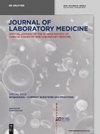Point-of-care haematological monitoring during treatment with clozapine
IF 1.8
4区 医学
Q4 MEDICAL LABORATORY TECHNOLOGY
引用次数: 3
Abstract
Abstract Objectives Patients treated with clozapine are required to have regular venous blood samples taken to measure white blood cell (WBC) and neutrophil counts to reduce the risk of agranulocytosis. The need for regular venous blood sampling can deter patients and clinicians from treatment with clozapine. Finger prick sampling offers patients a simpler and less invasive technique that is likely to be more acceptable. We undertook to evaluate a novel point of care testing (POCT) device which measures WBC and neutrophil counts using a small volume of capillary blood from a finger prick sample. Methods A total of 215 patients who were being treated with clozapine and were having a venous blood sample taken for haematological monitoring also provided a fingerprick capillary blood sample. The capillary and venous samples were tested using the Sight OLO® POCT analyser, and the venous sample also tested using a standard laboratory method. Results For both the WBC and the neutrophil counts, there was a strong correlation between the results from the standard laboratory venous method and the POCT assay (R=0.94 and 0.95, respectively for capillary blood samples, and R=0.98 for both WBC and neutrophil counts for venous blood samples). Compared with the standard laboratory venous blood method, mean biases were −1.0×109/L for WBC and −0.5×109/L for neutrophils for the capillary blood POCT method, and −0.4×109/L for WBC and −0.4×109/L for neutrophils for the venous blood POCT method. Overall, 6 of 215 (2.8%) of patients had levels below clozapine monitoring thresholds (WBC <3.5×109/L and Neutrophils <1.5×109/L) by capillary blood, and 5 (2.3%) by venous blood by POCT. Of these, 2 had sub-threshold counts on the standard laboratory method. Conclusions The POCT analyser provided results for both WBC and neutrophil counts that were comparable with those from a standard venous blood laboratory method. Using POCT devices may make haematological monitoring easier in patients being treated with clozapine, and thereby increase the use of clozapine in the treatment of schizophrenia.氯氮平治疗期间的护理点血液学监测
摘要目的氯氮平治疗的患者需要定期采集静脉血样,测量白细胞(WBC)和中性粒细胞计数,以降低粒细胞缺乏症的风险。需要定期静脉抽血可以阻止患者和临床医生使用氯氮平进行治疗。手指点刺采样为患者提供了一种更简单、侵入性更小的技术,可能更容易被接受。我们着手评估一种新型的护理点检测(POCT)设备,该设备使用手指点刺样本中的少量毛细管血测量WBC和中性粒细胞计数。方法对215例氯氮平患者进行血液学监测,并对其静脉血样进行了指刺毛细管血样检测。毛细管和静脉样品使用Sight OLO®POCT分析仪进行测试,静脉样品也使用标准实验室方法进行测试。结果对于WBC和中性粒细胞计数,标准实验室静脉法和POCT测定的结果之间存在很强的相关性(毛细管血样的R分别为0.94和0.95,静脉血样的WBC和嗜中性粒细胞数的R均为0.98)。与标准实验室静脉血法相比,毛细管血POCT法的WBC和中性粒细胞的平均偏差分别为−1.0×109/L和−0.5×109/L,静脉血POCT方法的WBC的平均偏差为−0.4×109/L。总的来说,215名患者中有6名(2.8%)的毛细血管血水平低于氯氮平监测阈值(WBC<3.5×109/L,中性粒细胞<1.5×109/L),5名(2.3%)的静脉血水平低于POCT监测阈值。其中,2人的计数低于标准实验室方法的阈值。结论POCT分析仪提供的WBC和中性粒细胞计数结果与标准静脉血实验室方法的结果相当。使用POCT设备可以使氯氮平治疗患者的血液学监测更容易,从而增加氯氮平在精神分裂症治疗中的使用。
本文章由计算机程序翻译,如有差异,请以英文原文为准。
求助全文
约1分钟内获得全文
求助全文
来源期刊

Journal of Laboratory Medicine
Mathematics-Discrete Mathematics and Combinatorics
CiteScore
2.50
自引率
0.00%
发文量
39
审稿时长
10 weeks
期刊介绍:
The Journal of Laboratory Medicine (JLM) is a bi-monthly published journal that reports on the latest developments in laboratory medicine. Particular focus is placed on the diagnostic aspects of the clinical laboratory, although technical, regulatory, and educational topics are equally covered. The Journal specializes in the publication of high-standard, competent and timely review articles on clinical, methodological and pathogenic aspects of modern laboratory diagnostics. These reviews are critically reviewed by expert reviewers and JLM’s Associate Editors who are specialists in the various subdisciplines of laboratory medicine. In addition, JLM publishes original research articles, case reports, point/counterpoint articles and letters to the editor, all of which are peer reviewed by at least two experts in the field.
 求助内容:
求助内容: 应助结果提醒方式:
应助结果提醒方式:


